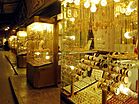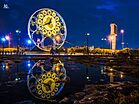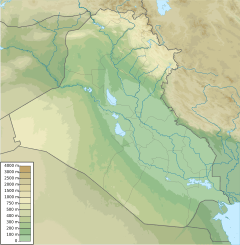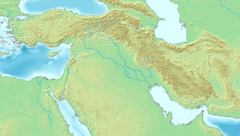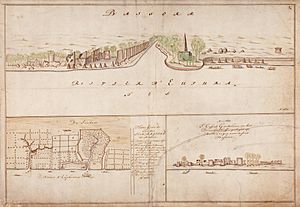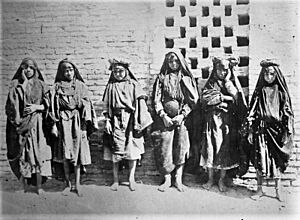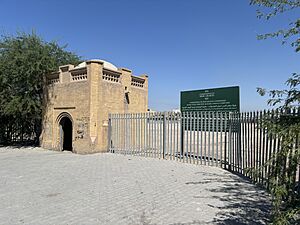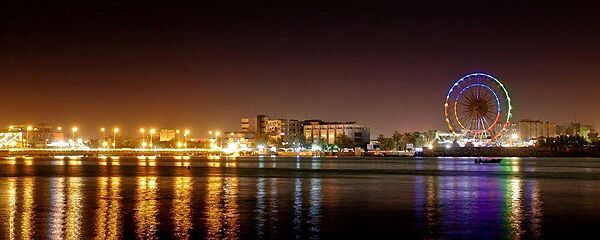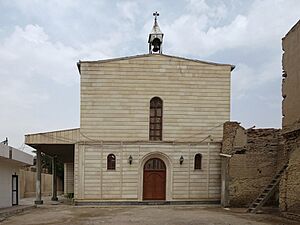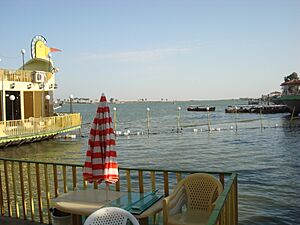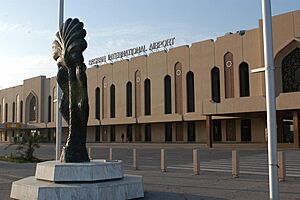Basra facts for kids
Quick facts for kids
Basra
ٱلْبَصْرَة
Basrah
|
|
|---|---|
| Nickname(s):
Venice of the East
|
|
| Country | |
| Governorate | Basra |
| Founded | 636 AD |
| Government | |
| • Type | Mayor–council |
| Area | |
| • Metropolis | 50-75 km2 (21.0 sq mi) |
| • Metro | 181 km2 (70 sq mi) |
| Elevation | 5 m (16 ft) |
| Population
(2024)
|
|
| • Metropolis | 1,485,000 |
| Time zone | UTC+3 (AST) |
| Area code(s) | (+964) 40 |
Basra (Arabic: ٱلْبَصْرَة, romanized: al-Baṣrah) is a major city in southern Iraq. It is the capital and largest city of the Basra Governorate. It is also the third largest city in Iraq, after Baghdad and Mosul. Basra is located near the Iran–Iraq border, along the banks of the Shatt al-Arab river. This river flows into the Persian Gulf. Most people in Basra are Shia Muslim Arabs.
Basra is known as one of the hottest cities in Iraq. Summer temperatures often go above 50 °C (122 °F). The highest temperature ever recorded in Basra was 53.9°C.
Historically, Basra is famous as one of the ports from which the legendary Sinbad the Sailor began his journeys. The city was built in 636 AD and was very important during the Islamic Golden Age. It has been ruled by different empires, including the Safavid and Ottoman empires. During World War I, the British took control of Basra. Later, it became part of the independent Kingdom of Iraq in 1932. Basra faced many challenges during the Iran–Iraq War, the Gulf War, and the 2003 invasion of Iraq.
Today, Basra is Iraq's main port, even though it doesn't have very deep water access. A new, very large port called the Grand Faw Port is being built. This port is expected to make Iraq a major player in shipping in the Middle East. In 2017, the Iraqi Parliament officially recognized Basra as Iraq's economic capital. The city is a key center for business and industry, especially for things like oil and chemicals.
Contents
What's in a Name? Basra's Meaning
The city has had many names over time, but Basra is the most common. In Arabic, baṣrah means "the overwatcher." This name might refer to the city's start as a military base. Another idea is that the name comes from an old word, basratha, which means "place of huts" or "settlement."
Basra's Journey Through Time
How Basra Was Founded (636–661 AD)
Basra was founded in 636 AD, at the beginning of the Islamic era. It started as a military camp for Arab soldiers. A small hill south of the modern city still shows where the original camp was. The Muslim commander Utbah ibn Ghazwan set up his camp here after defeating the Sassanid Empire. The city was named Al-Basrah, meaning "the over watching," because it was a military base. Some say the name comes from a Persian word meaning "where many ways come together."
In 639 AD, the Caliph Umar made the camp a city with five areas. He appointed Abu Musa al-Ash'ari as its first governor. The city was built in a circular shape. Basra quickly grew into one of the largest cities in the Islamic world.
Building Basra: Early Challenges
It's not entirely clear why Basra was built where it was. The original site was far from the Shatt al-Arab river, so it didn't have easy access to sea trade or fresh water. Also, there wasn't much farmland around the city at first. One story says that early settlers complained they had only "reedy salt marsh" and no good land for farming.
Despite these challenges, Basra grew fast. Since it was a military camp, soldiers needed food and had money to spend. So, both the government and private investors put a lot of money into building a huge farming system. This system included many canals to bring water to the fields.
However, these canals had a problem: they were built on land that was too flat, so salt from the water built up in the soil. Workers had to constantly remove the salty topsoil to keep the land fertile. After the city was attacked in the late 800s and early 900s, people stopped investing in fixing the irrigation system. The old city site was eventually abandoned, and a new Basra grew up along the banks of the Shatt al-Arab, where it is today.
Basra in the Golden Age (750–1258 AD)
During the time of the Abbasid Caliphate, Basra became a very important center for learning and ideas. It was home to the famous Basra School of Grammar, which was a rival to the Kufa School. Many brilliant thinkers lived in Basra, including the scientist Ibn al-Haytham, the writer al-Jahiz, and the Sufi mystic Rabia Basri.
The city faced some tough times. In 871 AD, a group called the Zanj attacked and damaged Basra. In 923 AD, another group, the Qarmatians, invaded and caused more destruction.
Later, from 945 to 1055 AD, the Iranian Buyid dynasty ruled Baghdad and much of Iraq, including Basra. A library with 15,000 books was built in Basra during this time. The Seljuks later took control from the Buyids.
Mongol Rule and Beyond (1258–1500s)
In 1258 AD, the Mongols captured Baghdad. Basra chose to surrender to the Mongols to avoid being attacked. Maps from this period show Basra under Mongol control.
The famous traveler Ibn Battuta visited Basra in the 1300s. He described it as a city known worldwide, with beautiful courts and many fruit gardens. He noted that it was a meeting place for both fresh and salty waters. He also observed that Basra had three main areas, including one for Iranians, showing the city's long connection with Iran.
In the early 1400s, local Arab tribes controlled Basra, but they were influenced by larger empires. Later, the Safavid dynasty took control of Basra in 1508. This was the first time Basra was part of the Safavid Empire. However, local rulers soon regained control. In 1536, the Ottoman Empire gained some influence over Basra, though their control was not very strong at first.
Portuguese and Ottoman Influence

In the 1500s, the Portuguese also became involved in the region. They visited Basra in 1523 and even took control of it briefly in 1529. From 1595, the Portuguese acted as military protectors of Basra. In 1624, they even helped the Ottoman governor of Basra fight off a Persian invasion. In return, the Portuguese were allowed to share in customs money and didn't have to pay tolls.
Basra was a busy trading and cultural center for a long time. The Ottoman Empire fully captured it in 1668. The city was often fought over by the Turks and Persians, and people in Basra often resisted foreign rule.
British Rule and World Wars
During World War I, British forces captured Basra from the Ottomans in November 1914. British officials and engineers then modernized Basra's port. This made it one of the most important ports in the Persian Gulf, creating new trade links with India and East Asia.
There is a British War Cemetery in Basra with graves of about 5,000 men from World War I. Another 40,000 soldiers who have no known grave are remembered at the Basra Memorial.
During World War II, Basra was an important port for sending supplies to the Soviet Union from other Allied countries.
Basra in Modern Times (1921–Present)
Basra's population grew significantly, reaching about 1.5 million people by 1977. The University of Basrah was founded in 1964.
However, the city's population dropped during the Iran–Iraq War (1980-1988). Basra was heavily shelled by Iran and saw many fierce battles. After the war, there was a rebellion against the Iraqi government in Basra in 1991, which was put down.
In 2003, during the start of the Iraq War, British forces captured Basra. The city was the first major stop for the United States and the United Kingdom during the invasion. In 2004, a series of bomb blasts killed many people in the city.
In 2007, the British handed over control of Basra province to the Iraqi authorities. In March 2008, the Iraqi Army launched a major operation to remove armed groups from Basra.
In recent years, Basra has faced challenges like a lack of clean drinking water and electricity. In 2018, protests broke out over these issues. However, in 2023, the city successfully hosted the 25th Arabian Gulf Cup football tournament, which the Iraqi team won.
Basra's Location and Weather
Basra is located on the Shatt al-Arab waterway, about 110 km (68 mi) from the Persian Gulf. The city has many canals and streams that are important for farming. These canals were once used for transport, but pollution and low water levels have made them difficult to use for boats.
Basra's Climate: Hot and Humid
Basra has a hot desert climate. During the summer, from June to August, Basra is one of the hottest cities in the world. Temperatures often go above 50 °C (122 °F) in July and August. The highest temperature ever recorded in Basra was 53.9 °C (129.0 °F) on July 22, 2016. This is one of the hottest temperatures ever measured on Earth!
In winter, Basra is mild and a bit wet, with average high temperatures around 20 °C (68 °F). Sometimes, night temperatures can drop below freezing. The air is often very humid because the city is close to the marshy Persian Gulf.
| Climate data for Basra (1991-2020) | |||||||||||||
|---|---|---|---|---|---|---|---|---|---|---|---|---|---|
| Month | Jan | Feb | Mar | Apr | May | Jun | Jul | Aug | Sep | Oct | Nov | Dec | Year |
| Record high °C (°F) | 34.0 (93.2) |
39.0 (102.2) |
42.6 (108.7) |
43.5 (110.3) |
50.0 (122.0) |
51.6 (124.9) |
53.9 (129.0) |
52.2 (126.0) |
50.7 (123.3) |
46.8 (116.2) |
39.7 (103.5) |
30.0 (86.0) |
53.9 (129.0) |
| Mean daily maximum °C (°F) | 18.7 (65.7) |
21.7 (71.1) |
26.8 (80.2) |
33.4 (92.1) |
40.3 (104.5) |
45.0 (113.0) |
47.0 (116.6) |
47.2 (117.0) |
43.3 (109.9) |
37.2 (99.0) |
27.0 (80.6) |
20.5 (68.9) |
34.0 (93.2) |
| Daily mean °C (°F) | 13.0 (55.4) |
15.5 (59.9) |
20.2 (68.4) |
26.6 (79.9) |
33.3 (91.9) |
37.4 (99.3) |
38.9 (102.0) |
38.5 (101.3) |
34.7 (94.5) |
28.8 (83.8) |
20.0 (68.0) |
14.4 (57.9) |
26.8 (80.2) |
| Mean daily minimum °C (°F) | 8.3 (46.9) |
10.1 (50.2) |
14.3 (57.7) |
20.1 (68.2) |
26.2 (79.2) |
29.1 (84.4) |
30.7 (87.3) |
29.9 (85.8) |
26.3 (79.3) |
21.7 (71.1) |
14.4 (57.9) |
9.6 (49.3) |
20.1 (68.1) |
| Record low °C (°F) | −4.7 (23.5) |
−4.0 (24.8) |
1.9 (35.4) |
2.8 (37.0) |
8.2 (46.8) |
18.2 (64.8) |
22.2 (72.0) |
20.0 (68.0) |
13.1 (55.6) |
6.1 (43.0) |
1.0 (33.8) |
−2.6 (27.3) |
−4.7 (23.5) |
| Average precipitation mm (inches) | 26.9 (1.06) |
17.7 (0.70) |
18.5 (0.73) |
12.8 (0.50) |
4.0 (0.16) |
0 (0) |
0 (0) |
0 (0) |
0 (0) |
6.6 (0.26) |
19.1 (0.75) |
25.2 (0.99) |
130.8 (5.15) |
| Average rainy days | 4 | 2 | 2 | 2 | 1 | 0 | 0 | 0 | 0 | 1 | 2 | 3 | 17 |
| Average relative humidity (%) | 66.3 | 56.8 | 47.0 | 38.6 | 26.8 | 20.5 | 21.8 | 23.6 | 27.2 | 38.5 | 53.8 | 66.1 | 40.6 |
| Mean monthly sunshine hours | 186 | 198 | 217 | 248 | 279 | 330 | 341 | 310 | 300 | 279 | 210 | 186 | 3,084 |
| Mean daily sunshine hours | 6 | 7 | 7 | 8 | 9 | 11 | 11 | 10 | 10 | 9 | 7 | 6 | 8 |
| Source 1: WMO, Climate-Data.org | |||||||||||||
| Source 2: Weather2Travel for rainy days and sunshine Ogimet Meteomanz | |||||||||||||
How Climate Change Affects Basra
Basra was once famous for its farming. However, rising temperatures, more salty water, and the spread of deserts have changed this.
Who Lives in Basra?
Most people in Basra are Arabs from different tribes. There are also some Feyli Kurds who live on the eastern side of the city and are mainly merchants.
Basra is also home to a community of Afro-Iraqi people, known as Zanj. These are descendants of African people brought to Iraq as slaves in the 900s. Today, about 200,000 Zanj live in Iraq.
Basra's Religions
Basra is a major Shia Muslim city. The number of Sunni Muslims is small and decreasing as more Shia Iraqis move to Basra for work.
A small number of Assyrian Christians live in Basra. Many of them are refugees who fled from persecution by ISIS in other parts of Iraq. However, after Iraq's victory against ISIS in 2017, many Christians have returned to their homes. There are a few thousand Christians in Basra today. One of the largest communities of Mandaeans, an ancient religious group, also lives in the city.
Exploring Basra's Landmarks

- The Old Mosque of Basra was the first mosque built in Islam outside the Arabian Peninsula.
- Sinbad Island is in the middle of the Shatt Al-Arab river and is a popular tourist spot.
- The Muhhmad Baquir Al-Sadr Bridge connects the Tigris and Euphrates Rivers. It was finished in 2017.
- You can find the ruins of the house of the famous poet Badr Shakir al-Sayyab in Basra. There's also a statue of him on the Basra Corniche.
- Basra Sports City is the largest sports complex in the Middle East.
- Palm tree forests are common along the Shatt al-Arab waterway, especially in the nearby village of Abu Al-Khasib.
- Corniche al-Basra is a street along the Shatt al-Arab. The Basra International Hotel, known for its traditional Shanasheel design, is located here.
- The Sayyed Ali al-Musawi Mosque is in the city center.
- Basra Land (formerly Fun City) is one of the oldest and largest theme parks in southern Iraq. It was damaged in the war but has been rebuilt.
- Akhora Park is one of the city's older parks.
- There are four official presidential palaces in Basra.
- The Indian Market (Amogaiz) is a main bazaar, named because Indian sellers worked there long ago. The Hanna-Sheikh Bazaar is another old market.
Basra's Economy: Oil and Trade
Basra's economy mostly depends on the oil industry. Iraq has the world's fourth-largest oil reserves. Most of Iraq's oil exports leave from the Al Basrah Oil Terminal. The Basra Oil Company has its main office in the city.
A lot of economic activity in Basra is also around the petrochemical industry. This means making chemicals from oil and natural gas. Companies here produce things like ammonia, urea, and plastics.
Basra is in a good area for farming. Important crops include rice, corn, barley, wheat, and dates. Basra was once famous for its high-quality dates.
Shipping, logistics, and transport are also big industries. Basra has all six of Iraq's ports. Umm Qasr is the main deep-water port. The city also has an international airport with flights to Baghdad. Before the oil boom, fishing was also an important business.
Sports in Basra
Basra is home to the largest sports stadium in Iraq, the Basra International Stadium. This stadium hosts many matches for the Iraq national football team. The city also has a sports team called Al-Minaa, which uses the Al-Minaa Olympic Stadium as its home field. Their basketball team is one of the top Arab teams.
Famous People from Basra
- Rabi'a al-'Adawiyya: An early Muslim mystic.
- Ibn al-Haytham: A medieval mathematician, astronomer, and physicist.
- Saadi Youssef: A poet.
- Sean Polley: An English cricketer, born in Basra.
- Reham Yacoub: A female activist.
- Farid Allawerdi: A composer.
- Hussein Jabur: A footballer.
Basra's Sister Cities
Basra is connected with these cities around the world:
Basra in Stories
- In Voltaire's book Zadig, "Bassora" is a big international market where people from all over the world meet.
- In H. G. Wells's 1933 book "The Shape of Things to Come", Basra becomes the capital of the world after civilization collapses.
- In the 1940 film The Thief of Bagdad, the characters Ahmad and Abu escape to Basra.
See also
 In Spanish: Basora para niños
In Spanish: Basora para niños





